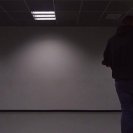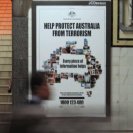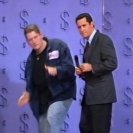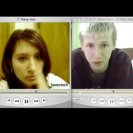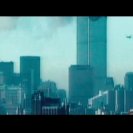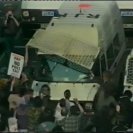In Larry Emdur’s Suit (2002) Emile Zile turned a stroke of good luck into one of the most remarkable video art pieces of the last ten years. With a chance to be an audience member on long-running TV show The Price Is Right, Zile was doubly fortunate to be chosen as a contestant. With just a few minutes in the spotlight, the hyperactive Zile clowned around with presenter Larry Emdur while he attempted to guess the price of a set of nursery furniture. Ultimately defeated at the next stage of the show, Zile was nevertheless able to turn the experience into a video documenting the experience using little more than a home recording of the episode and a voice over.
Larry Emdur’s Suit is a distillation of the concerns of Zile’s continuing body of work —an examination of the effects of the mediation of experience through communications technology. Early works such as ...Social Revolt (1999) — with its montage of footage of crowds rioting set to a soundtrack featuring a sample of Gil Scott Heron’s song The Revolution Will Not Be Televised — questioned the nature of the representation of social actions through a series of representative visual clichés.
Zile’s work — crisscrossing the entire gamut of video art production, from single channel and multiple channel work to installations, performances and VJ-ing to music video and dance works — is united by this continuing fascination.
In Holy Cow (2006), Salo (93) (2007), and Performance Anxiety (2007) Zile examines the way the experience of ‘media events’ is constructed from a bricolage of visual cues from television, the web, newspapers, magazines and the cinema. In Holy Cow, Zile took online footage of September 11 to isolate the “holy cow” uttered by a horrified witness as the World Trade Tower was struck by the second airplane. This footage is juxtaposed with strobing footage of someone being hit by a model aircraft in a suburban backyard. The video concludes with a long sequence of the artist asking passersby in a subway tunnel to stand and have their photo taken with him in front of poster asking the public to be on the lookout for suspicious characters. Zile’s comic video particularises the experience of terrorism as a media event while contextualising the effects of a real world incident in an immediate and physical manner.
Salo (93) returned obliquely to this idea through the juxtaposition of two seemingly conflicting, yet disturbingly appropriate, elements: footage from the film United 93 (2006) and the soundtrack and subtitles from Pier Paolo Passolini’s Salo (1975). United 93 dramatised the hijack of a passenger plane on 9/11 which was flown into the ground after an uprising by the passengers. Salo was concerned with an updating of the Marquis de Sade’s tale of extreme sado-masochism to Fascist Italy. While it would seem that these two films had nothing in common, images of the terror stricken passengers attempting to take fate into their own hands seemed appropriately captioned by subtitles which read: “To the end of eternity ... if eternity can have an end”. Zile’s exploration of the cult of Steve Irwin, and the outpouring of grief and puzzlement at the manner of the late naturalist’s death by stingray barb to the heart, formed the centre of Performance Anxiety.
As a video DJ, music video and installation maker — and in collaboration with musicians, dancers and performance artists — Zile has explored the meeting of live performance with the collective media memory. In Apocalypse P.R.D. (2006) — a work made with choreographers Paul Emmanuel and Frances d’Ath during a six week residency at Park19 Artspace in Guangzhou, China — Zile concocted an elaborate staging for a dance piece that referenced the film Apocalypse Now (1979) through the use of dialogue and image fragments. Zile’s work with improvisation group Morloch (2004–05) created a dynamic music/video environment that riffed on found fragments and musical cacophonies. For Phantom Mass (2006), an audience was asked to sit inside a velvet curtain-draped room in a football stadium and listen to a 5.1 surround sound recording of football fans outside. It was only when the curtains were drawn back to reveal an empty stadium did the audience realise that the images the sound had conjured were a concocted illusion.
Five production company logos in 3D, Diane Tanzer Gallery + projects, Melbourne Australia. April 2-23, 2011.
The audience is listening, Fette’s Gallery, Los Angeles January 8 – February 8 2009.
Steve Irwin, DVD Video and the stink of the future, Het Wilde Weten, Rotterdam, The Netherlands.
Emile Zile: Art and the Mutation of Mass Media’ Spielraum, Berlin, 2007.
Springer Audiences ’84-’04, Kings Gallery, Melbourne, Next Wave Festival 2006 Visual Arts Program.
Emile Zile Video Works 1999-2005, Footscray Arts, Gabriel Gallery, 2005.
Photo Deceased, Bus Gallery Melbourne. May 2004.
Three Artists Walk into a Bar, De Appel Amsterdam May 2012.
Boo Australia, Matucana 100, Santiago, Chile, April 24 – May 27 2012.
Rietveld/1mins Arsenale, Venice Biennale 2009 4 June – 19 July 2009.
The Leisure Class, Queensland Art Gallery, Brisbane Australia. 13 October 2007 – March 2008;
Clip Art, Firstdraft, Sydney, Wrong Time Wrong Place, TENT, Rotterdam, The Netherlands.
Home is somewhere else, Duende Studios Rotterdam, The Netherlands, 2007.
Hijacked Video Edition, Perth Institute of Contemporary Art, 2006.
Graffiti Released, New Ruins group exhibition, Melbourne, 2006.
‘Signalling, not clowning’ Urzsula Dawkins review of ‘Five Production Company Logos in 3D’ in Realtime 103.
http://www.realtimearts.net/article/103/10353
‘Ego Logos & Euclidean Cum Shots’ Philip Brophy catalogue essay on ‘Five Production Company Logos in 3D’ at Dianne Tanzer gallery + projects April 2 – 23 2011.
http://philipbrophy.com/projects/rstff/EgoLogos_C.htmlTaken To The Streets, Realtime #73, June-July 2006. Fame lurks in unusual places, The Age, March 17, 2006.
A walk through the woods with Zile, Cut-up, September 13, 2005. An exhibition of themselves, The Age, May 21, 2004.
